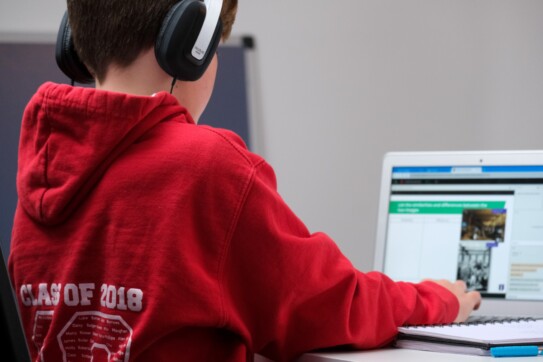What are the Best Practices for Distance Learning Assessments?

The transition from traditional classroom education to distance learning has raised many questions regarding assessments. Is there a testing method that best fits online learning? What e-learning tools should schools use for quizzes and exams? How can teachers ensure the integrity of assessments? And how does all of this impact a student’s final grade?
The answers are found in the continually evolving journey that schools are experiencing with distance learning. “Phase one for us was to hit the ground running,” said Tammy Earle, director of technology and learning initiatives at Rothesay Netherwood School (RNS) in Rothesay, New Brunswick, “and it wasn’t about assessments at all. It was making sure the kids were okay, connecting with them, and just getting a routine established. So the assessment piece for the first three to four weeks was on hold.”
“What we found was that students needed twice the amount of time when completing tasks online, and it took time to get the right balance between synchronous and asynchronous learning. Once we established that, then we started talking more about the assessment piece.”
These early distance learning lessons created a realization for RNS that assessments needed to make use of the school’s existing ed-tech solutions. “The rule for us was—don’t try to infuse a bunch of new tools, because then you end up focusing on technology and not on the actual course material and learning outcomes.
“Not all teachers were using the Blackbaud discussion boards, but they found a way to do that rather than go find a new discussion board tool. It’s important for them to use the integrated tools because the kids have familiarity, and so it’s one less thing they have to worry or stress about.”
At Barstow School in Kansas City, Missouri, Science Department Chair Dr. Caroline Kill has seen the school undergo a similar online learning journey. With a growing understanding and empathy for the transition’s impact on student learning, Barstow’s administration issued recommendations for final exams.
“Normally for the Upper School, final exams are anywhere between ten to twenty percent of the semester grade,” Kill said. “We were told that if we wanted to do a final exam, it had to be within our new forty-five minute class period, and we were encouraged to lower the percentage to five percent. We can also do an alternate assessment, which is what I’m going to do with my ninth-grade biology class.”
Determining equitable ways to calculate grades during distance learning raises the question of whether K–12 schools should switch to pass-fail grading. As with most private schools, this possibility was discussed at the schools interviewed for this article, and all three decided against it.
“We felt like we had enough numerical and effort reports by March that we could continue to do so,” Earle said. “This also motivates the students because they know that if they have an eighty-eight, they can still improve their overall scores by working hard, whereas with pass-fail, you’re just saying, ‘Here’s the line.’”
At Sanford School in Hockessin, Delaware, Head of Middle School Emily Amendum says that the data they collected from parents and students supported the school’s decision to keep the existing grading structure.
“For students who expressed this preference, the biggest driver was that they wanted the grades as a marker of their achievement and they also wanted the chance to improve upon a grade that they were not happy with from the first semester. For parents who wanted grading to continue, they were using the grades received as a way to measure how students were faring with distance learning.
“Having said that, this is an area in which we have allowed flexibility in terms of student and family needs. For students who have had difficulty with the independence required of distance learning, we have turned some of their classes to non-graded.” While these students continue to do their coursework, their “end-of-year grade will be based upon the grade they received in the first semester.”
“We have a responsibility to serve the students the very best that we can,” Kill said. “Barstow is a college-prep school, and families pay tuition to attend, so there’s a sense of duty to provide them with as close to an equivalent in-class experience as can be done with the limitations.”
How does this responsibility to deliver a first-class educational experience translate to assessments? At Barstow, Kill is seeing teachers administer a variety of assessment types based on their subject areas. In this regard, traditional assessment formats such as multiple-choice quizzes are still getting used where applicable, but there’s a growing understanding of how to adapt assessments to match online learning methodologies.
“It has been a very challenging time and it has really stretched all of us to learn in new ways,” she said. “As a science teacher, I really miss labs. So much of science is hands-on, but the kids don’t have test tubes and beakers at home, so I’ve had to rethink assessments to be more global as opposed to referring to procedures they would have learned in a lab. It’s been a new way to think about—what’s the big picture that these students need to know when they walk out of here?”
This rethinking has put more emphasis on project-based learning with rubrics and essay-type assessments. “Before all this happened, I used multiple-choice to make sure students were getting the basic concepts,” Kill said, “but now students can Google the answers to those questions, so I’ve been using assessments where students have to write and explain their reasoning and implement things in a new way.”
A similar focus on long-term projects is taking root at Sanford School. “While teachers have continued to use all types of assessment in distance learning, this type of summative assessment is the one that is most frequently being utilized,” Amendum said.
At the middle school level, an influx of long-term projects has also put an emphasis on student support. “Long-term projects can be difficult for students to manage remotely, especially when they have projects for multiple classes. We have worked to put some structures in place to support the students who do struggle with the management of longer projects, including a Google Doc for each grade level that lists the ongoing projects and the date these are due.
“Additionally, we have implemented virtual study halls where students who need additional guidance check in with our counselor and learning support specialist or dean of students to discuss the progress that has been made and create a plan outlining work the student needs to complete during independent work times that are built into the schedule.”
Earle sees student support as a factor in choosing virtual assessment methodologies. “Changing it up is important. I like to differentiate with the kids. Sometimes, I like the discussion board because it allows them to have a voice—especially the shy or quiet students. Some people are better with text, so sometimes we do it that way. It’s really about picking your learning objective first.”
Knowing the learning objective also means that multiple-choice questions still have a place in the e-learning environment. “We do have a responsibility to get students properly prepared for the ACT and the SAT,” Kill said, “and so I would be remiss not to give students practice doing multiple choice.”
How can teachers ensure the integrity of online multiple-choice tests? Earle notes that some RNS teachers are giving quizzes and tests during Zoom meetings. The purpose isn’t to catch students in the act of cheating; instead, it’s to provide faculty support for questions so students aren’t tempted to ask classmates for help. Setting time limits is another measure to keep students focused on the task at hand.
“I love the fact that you can alter the times now for students,” Earle said, referring to the recent Blackbaud Student Information SystemTM enhancement to set assessment time limits for individual students, “because that is a game-changer. It makes a big difference because we have students with different learning requirements.”
Another school of thought is to embrace the idea of open-book assessments in online learning. “We are changing the way we think and how we ask questions. We told our faculty to think about assessments in terms of open book, and it took them a little bit of time to think, ‘Okay, what does that look like, and how does it work for my class?’ So our language teachers might say, ‘I was doing an oral component anyway, so that’s going to be part of it, and there’s going to be a written component.’”
At Sanford, Amendum sees teachers administering open- and closed-book assessments, which they view as another learning opportunity. “There is an element of trust as we can not truly monitor what is happening on the other side of the screen,” she said. “We do use it as a teachable moment in regard to our honor code and what academic integrity really means.”
As challenging as the transition to distance learning has been for everyone involved, Kill sees a silver lining. “I think more responsibility has been placed on the kids to apply the information they’re learning in new and novel ways with rubrics and competencies,” she said. “I think this is going to have an everlasting effect on teaching and assessments. In some ways, this has been a really good challenge because it has improved instruction in a very modern way.”


